PDF-16 IDD NEWSLETTER MAY 2015 CASE STUDY
Author : mary | Published Date : 2022-10-12
An 88yearold Chinese woman was brought to the emergency department by her family who reported that she had been lethargic and unable to walk or swallow for 3 days
Presentation Embed Code
Download Presentation
Download Presentation The PPT/PDF document "16 IDD NEWSLETTER MAY 2015 CASE ST..." is the property of its rightful owner. Permission is granted to download and print the materials on this website for personal, non-commercial use only, and to display it on your personal computer provided you do not modify the materials and that you retain all copyright notices contained in the materials. By downloading content from our website, you accept the terms of this agreement.
16 IDD NEWSLETTER MAY 2015 CASE STUDY: Transcript
Download Rules Of Document
"16 IDD NEWSLETTER MAY 2015 CASE STUDY"The content belongs to its owner. You may download and print it for personal use, without modification, and keep all copyright notices. By downloading, you agree to these terms.
Related Documents














